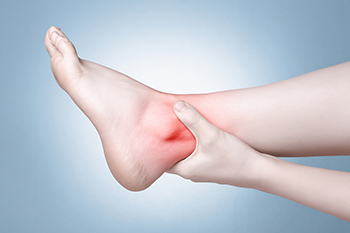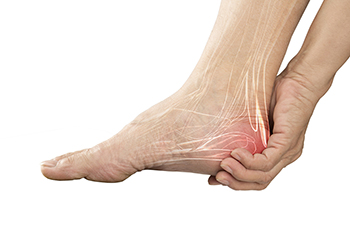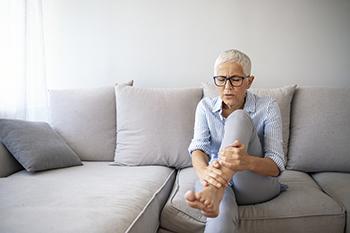Oceanside (760) 630-9200
June 2022
What to Do for Ankle Pain

Ankle pain refers to any kind of discomfort or pain in the ankles. Such discomfort may come from an injury, a sprain, or a medical condition. An ankle sprain is one of the most common causes of ankle pain. A sprain is when the ligaments, or tissues connecting bones, tear or become overstretched. Most of these strains occur when the foot rolls and the outside ankle twists towards the ground. Ankle sprains often swell and bruise. Pain can last for up to 14 days, but it may take several months for the injury to heal fully. Ankle pain can also be a result of a health condition, such as arthritis, gout, or an infection in a joint. Rest can help ankle pain and once the pain subsides, gentle exercise of the ankles can help gain mobility back and reduce swelling. If the pain is from arthritis, there is no cure, but it can be managed by continuing to move, practicing stretching and strengthening exercises, and keeping body weight in a healthy range. If one has broken their ankle, it is important to consult with a podiatrist to see how bad the break is and if the ankle needs to be set or if surgery is necessary. If after giving an injury time to heal, and making lifestyle modifications, the pain worsens, or it becomes impossible to bear weight on the affected foot, it is suggested you see a podiatrist for proper diagnosis and treatment plan customized for you.
Ankle pain can be caused by a number of problems and may be potentially serious. If you have ankle pain, consult with Dr. Jeff Brooks from Oceanside Foot & Ankle Center. Our doctor will assess your condition and provide you with quality foot and ankle treatment.
Ankle pain is any condition that causes pain in the ankle. Due to the fact that the ankle consists of tendons, muscles, bones, and ligaments, ankle pain can come from a number of different conditions.
Causes
The most common causes of ankle pain include:
- Types of arthritis (rheumatoid, osteoarthritis, and gout)
- Ankle sprains
- Broken ankles
- Achilles tendinitis
- Achilles tendon rupture
- Stress fractures
- Bursitis
- Tarsal tunnel syndrome
- Plantar fasciitis
Symptoms
Symptoms of ankle injury vary based upon the condition. Pain may include general pain and discomfort, swelling, aching, redness, bruising, burning or stabbing sensations, and/or loss of sensation.
Diagnosis
Due to the wide variety of potential causes of ankle pain, podiatrists will utilize a number of different methods to properly diagnose ankle pain. This can include asking for personal and family medical histories and of any recent injuries. Further diagnosis may include sensation tests, a physical examination, and potentially x-rays or other imaging tests.
Treatment
Just as the range of causes varies widely, so do treatments. Some more common treatments are rest, ice packs, keeping pressure off the foot, orthotics and braces, medication for inflammation and pain, and surgery.
If you have any questions, please feel free to contact our office located in Oceanside, CA . We offer the newest diagnostic and treatment technologies for all your foot care needs.
Heel Pain Can Be Treated!
Foot Conditions in Children

Most children are born with flat feet and the arch will eventually develop. Several foot conditions may affect children in addition to having flat feet. Some children are born with bow legs, which is often noticeable as the leg below the knee bends outward. Research has indicated it often corrects itself as the growing process occurs. Pigeon toes, which are also known as in-toeing, are prevalent among babies and will begin to diminish as standing and walking begin. The opposite condition called out-toeing can be a common ailment and will correct itself as the child grows older. Many children walk on their toes as they learn how to walk and the body will eventually outgrow this too. Children between the ages of three and six may experience knock knees but treatment is rarely needed. If you notice that your child is experiencing any of these conditions, it is suggested that you consult with a podiatrist who can provide the treatment that is needed.
Making sure that your children maintain good foot health is very important as they grow. If you have any questions, contact Dr. Jeff Brooks of Oceanside Foot & Ankle Center. Our doctor can provide the care you need to keep you pain-free and on your feet.
Keeping Children's Feet Healthy
Having healthy feet during childhood can help prevent medical problems later in life, namely in the back and legs. As children grow, their feet require different types of care. Here are some things to consider...
Although babies do not walk yet, it is still very important to take care of their feet.
Avoid putting tight shoes or socks on his or her feet.
Allow the baby to stretch and kick his or her feet to feel comfortable.
As a toddler, kids are now on the move and begin to develop differently. At this age, toddlers are getting a feel for walking, so don’t be alarmed if your toddler is unsteady or ‘walks funny’.
As your child gets older, it is important to teach them how to take care of their feet.
Show them proper hygiene to prevent infections such as fungus.
Be watchful for any pain or injury.
Have all injuries checked by a doctor as soon as possible.
Comfortable, protective shoes should always be worn, especially at play.
If you have any questions please feel free to contact our office located in Oceanside, CA . We offer the newest diagnostic and treatment technologies for all your foot and ankle needs.
Plantar Warts Can Be Treated!
What Is Plantar Fasciitis?

The plantar fascia is a long, fibrous band of tissue on the bottom of the foot that connects the heel with the toes. It helps form the arch and stabilize the foot. The plantar fascia is in a constant state of flux—alternating between lengthening and contracting as we walk and run. Running and other physical activities can be taxing on the plantar fascia. So can being obese, standing at work all day, or wearing shoes that don’t offer proper arch support. Excessive strain and stress on the plantar fascia can cause it to become irritated, torn, inflamed, and ultimately painful. This is a condition known as plantar fasciitis, which is the most common form of heel pain. The pain of plantar fasciitis is most severe when you take your first steps in the morning. It can sometimes be alleviated by refraining from physical activity, icing the bottom of the feet, losing weight, or switching to more supportive footwear. If the pain does not subside, or worsens, it is suggested that you make an appointment with a podiatrist. Podiatrists treat plantar fasciitis frequently and have various treatments to repair the plantar fascia, reduce inflammation, and eliminate the heel pain it causes.
Plantar fasciitis can be very painful and inconvenient. If you are experiencing heel pain or symptoms of plantar fasciitis, contact Dr. Jeff Brooks from Oceanside Foot & Ankle Center. Our doctor can provide the care you need to keep you pain-free and on your feet.
What Is Plantar Fasciitis?
Plantar fasciitis is the inflammation of the thick band of tissue that runs along the bottom of your foot, known as the plantar fascia, and causes mild to severe heel pain.
What Causes Plantar Fasciitis?
- Excessive running
- Non-supportive shoes
- Overpronation
- Repeated stretching and tearing of the plantar fascia
How Can It Be Treated?
- Conservative measures – anti-inflammatories, ice packs, stretching exercises, physical therapy, orthotic devices
- Shockwave therapy – sound waves are sent to the affected area to facilitate healing and are usually used for chronic cases of plantar fasciitis
- Surgery – usually only used as a last resort when all else fails. The plantar fascia can be surgically detached from the heel
While very treatable, plantar fasciitis is definitely not something that should be ignored. Especially in severe cases, speaking to your doctor right away is highly recommended to avoid complications and severe heel pain. Your podiatrist can work with you to provide the appropriate treatment options tailored to your condition.
If you have any questions please feel free to contact our office located in Oceanside, CA . We offer the newest diagnostic and treatment technologies for all your foot and ankle needs.
Arthritis Can Cause Pain in the Feet and Ankles
Osteoarthritis of the Big Toe

Osteoarthritis or OA is a common form of arthritis that can affect any joint in the body. This type of arthritis generally increases with age, and those who are obese, have a genetic predisposition to it, or a prior joint injury are at higher risk. Cartilage in joints wear down, bones are exposed, and they can rub against each other. The base of the big toe is a common site for OA. The joint degenerates and the body may attempt to repair the condition by growing more bone. This reaction can create bony protrusions called bone spurs that appear as a visible bump or callus on the big toe joint. The excess bone growth can lead to fusion of the joint and it can become fixed/non-bending. The joint of the big toe may also look inflamed and swollen. It becomes painful and hard to walk if one cannot bend their toe, and if spurs or bunions develop, they can push uncomfortably against shoes. Usually, OA in the big toe is worse after inactivity, such as when first arising in the morning or after prolonged sitting. Wearing shoes that have sufficient room in the toe box and stiff soles, obtaining pad inserts or arch supports, using ice on the big toe, maintaining a healthy body weight, and/or taking over-the-counter pain relievers can help but there is no cure for OA. If you are suffering with big toe pain, consult with a podiatrist who can properly diagnose the condition and recommend a treatment plan to help you live more comfortably.
Arthritis can be a difficult condition to live with. If you are seeking treatment, contact Dr. Jeff Brooks from Oceanside Foot & Ankle Center. Our doctor can provide the care you need to keep you pain-free and on your feet.
Arthritic Foot Care
Arthritis is a term that is commonly used to describe joint pain. The condition itself can occur to anyone of any age, race, or gender, and there are over 100 types of it. Nevertheless, arthritis is more commonly found in women compared to men, and it is also more prevalent in those who are overweight. The causes of arthritis vary depending on which type of arthritis you have. Osteoarthritis for example, is often caused by injury, while rheumatoid arthritis is caused by a misdirected immune system.
Symptoms
- Swelling
- Pain
- Stiffness
- Decreased Range of Motion
Arthritic symptoms range in severity, and they may come and go. Some symptoms stay the same for several years but could potentially get worse with time. Severe cases of arthritis can prevent its sufferers from performing daily activities and make walking difficult.
Risk Factors
- Occupation – Occupations requiring repetitive knee movements have been linked to osteoarthritis
- Obesity – Excess weight can contribute to osteoarthritis development
- Infection – Microbial agents can infect the joints and trigger arthritis
- Joint Injuries – Damage to joints may lead to osteoarthritis
- Age – Risk increases with age
- Gender –Most types are more common in women
- Genetics – Arthritis can be hereditary
If you suspect your arthritis is affecting your feet, it is crucial that you see a podiatrist immediately. Your doctor will be able to address your specific case and help you decide which treatment method is best for you.
If you have any questions, please feel free to contact our office located in Oceanside, CA . We offer the newest diagnostic and treatment technologies for all your foot care needs.









